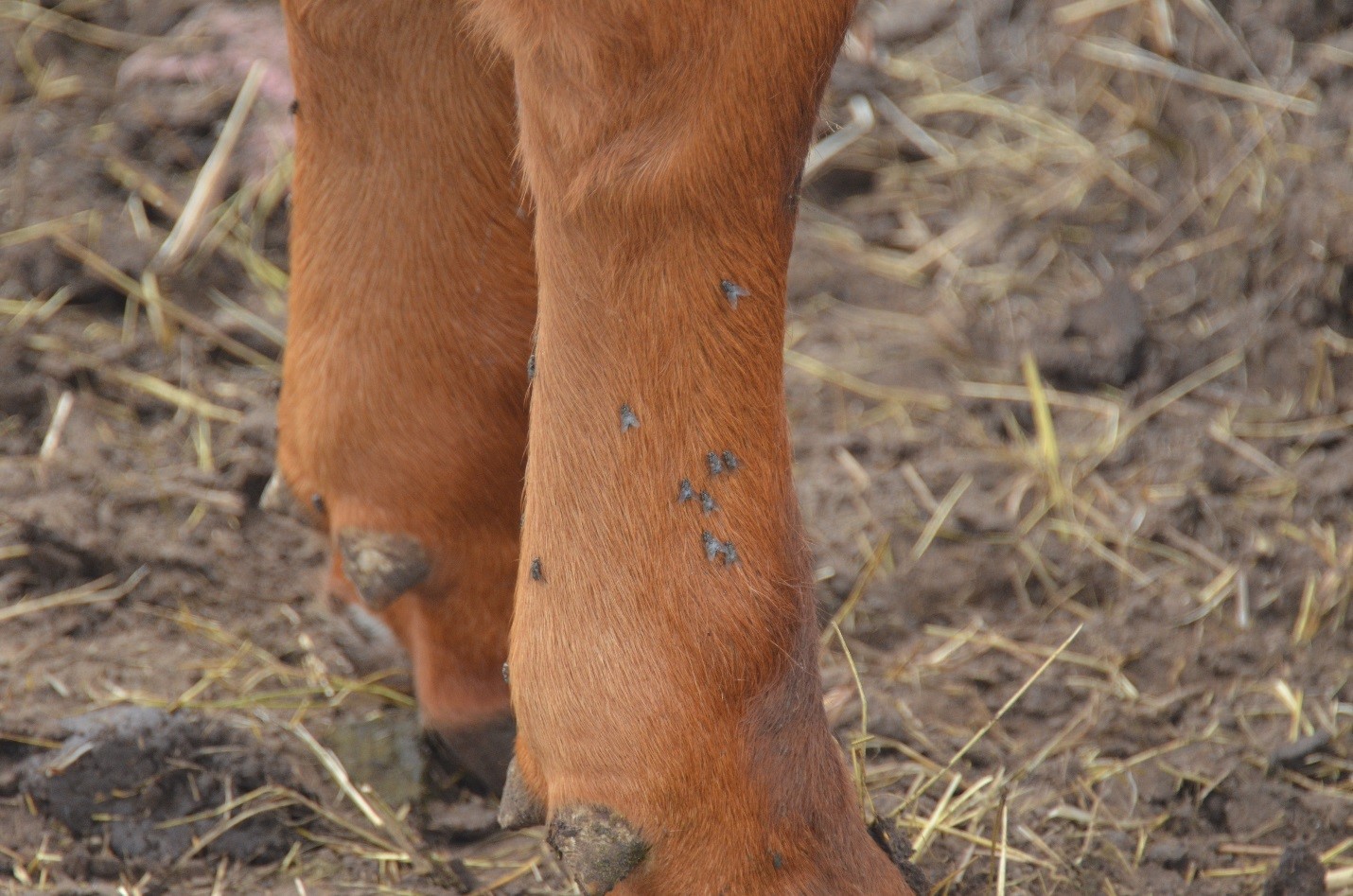
By Dave Boxler, Nebraska Extension Educator – Livestock Entomology
Stable fly injury to livestock is brought about in a number of ways. Both male and female flies partake of a blood meal, usually on the lower parts of the fore legs and under the belly. Their bite is quite painful; cattle react by stomping their legs, bunching in pasture corners, or standing in water to avoid being bitten. Stable flies feed until full, about two to five minutes, and then seek a suitable resting area to digest their blood meal (Figure 1 http://go.unl.edu/6d3g). Resting sites include shaded sites such as the underside of leaves of trees, shaded sides of buildings, shaded areas of windmill towers and water tanks, and even the underside of barbed wire. Digestion is usually completed in several hours. During warm conditions stable flies will feed several times a day, but during cool weather they normally feed once a day. The female stable fly requires at least three blood meals before depositing eggs. Stable flies do not develop in pure cow or horse manure, but in wet decaying organic material (old corn silage, spent hay, decaying straw, bagasse, and grass clippings) mixed with some horse or cow manure, and soil. The life cycle from egg to adult can take between 19 to 45 days to complete.
STABLE FLY IMPACT
The negative impact of stable fly feeding on cattle can be measured by increased anemia, decreased milk production, and decreased average daily gain ADG. Research conducted at the University of Nebraska West Central Research and Extension Center at North Platte, using yearling steers, observed a loss in ADG 0.44 lb/steer when not receiving an insecticide treatment. The economic threshold of 5 flies per leg is easily exceeded in Nebraska pastures (Figure 2 http://go.unl.edu/dtwx). Furthermore, cattle that bunch in pasture corners can cause fences to fail and blowouts to develop, especially in sandy pastures.
CONTROLLING STABLE FLIES
Controlling stable flies on pastured cattle is difficult due to the amount of time the fly spends away from the animal. Currently, animal sprays are the only adult management option available. Treatments can be applied with low pressure or mist blower sprayers. Weekly applications are often needed to reduce stable fly numbers. Targeting stable fly resting sites also may aid in reducing numbers. These sites should be targeted during warm afternoon temperatures with the same products used for animal application applied with low pressure or mist blower sprayers.
One of the major larval development sites that contributes to stable fly numbers is wasted feed near round bale feeders, especially when it has accumulated during winter feeding and adequate spring moisture has been present. These sites can generate thousands of stable flies. Sanitation or clean-up of these sites may reduce localized fly development. If clean-up is not an option these sites may be treated with a larvicide (Neporex®). However, either larval control procedure may not totally reduce the economic impact of stable fly feeding since stable flies can travel a significant distance from other larval development sites.
ROTATE INSECTICIDES TO REDUCE RESISTANCE
Fly populations are exhibiting higher tolerances to many labeled control products in the U.S. and in Nebraska. To manage insecticide resistance or tolerance, alternate insecticide classes.
Insecticides have been placed into numbered insecticide Mode of Action (MOA) groups based on how they work against insects. Mode of action groups include organophosphates (Group 1B), pyrethroids and pyrethrins (Group 3A), and cyromazine (Group 17).
Continual use from a single MOA against a species can lead to reduced control (resistance to all products in the group). To maintain efficacy, rotate between MOA groups during the fly season. A list of labeled insecticides, and their MOA are found in Table 1 (http://go.unl.edu/8aw9).
To listen to BeefWatch podcasts go to: https://itunes.apple.com/us/podcast/unl-beefwatch/id964198047 or paste http://feeds.feedburner.com/unlbeefwatch into your podcast app.